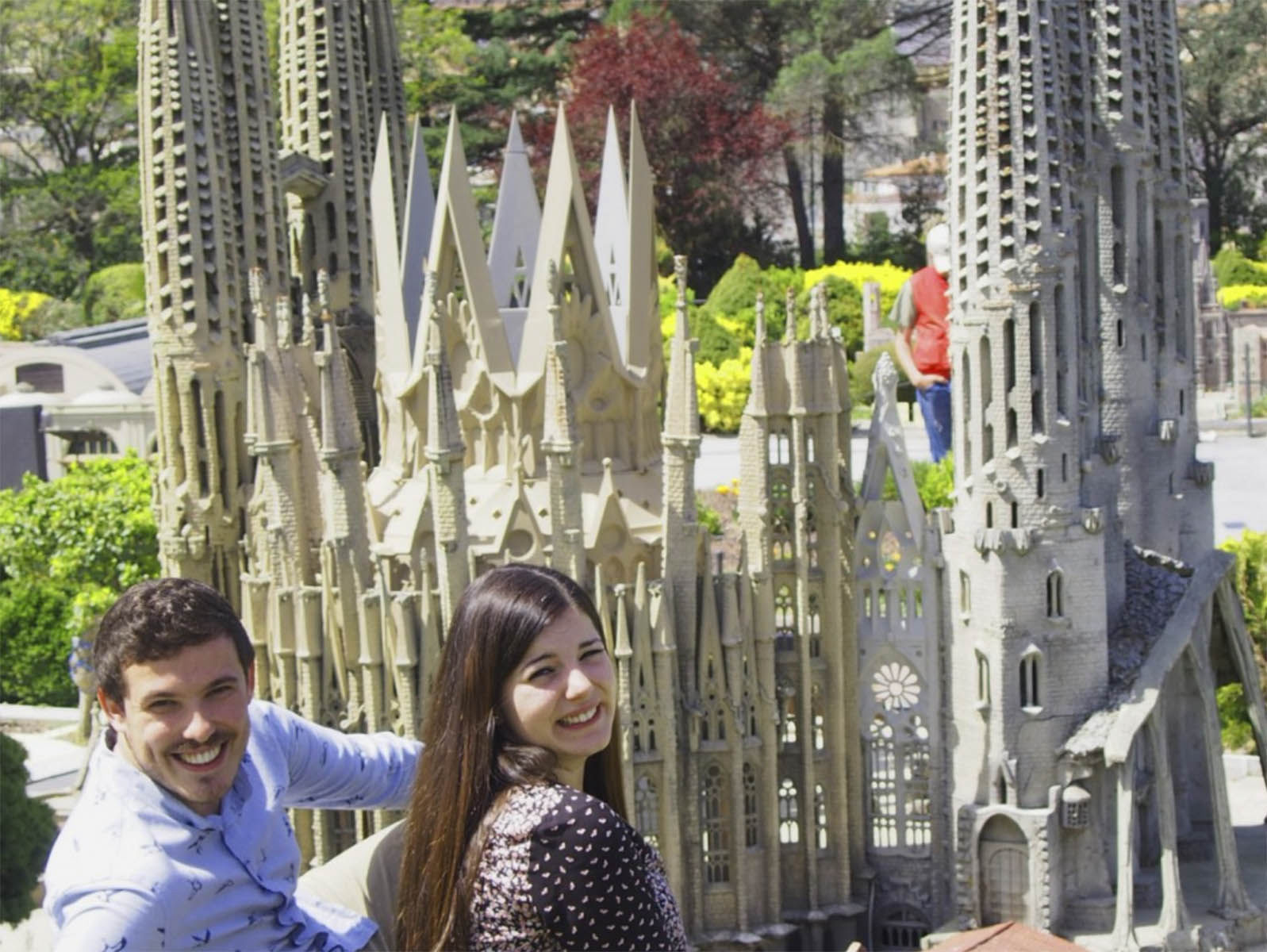
1. Welcome

Note: In this web page are not avaliable all audios. You can rent this audio guide service in Catalunya en Miniatura Park.
Welcome to Catalunya en Miniatura!!!
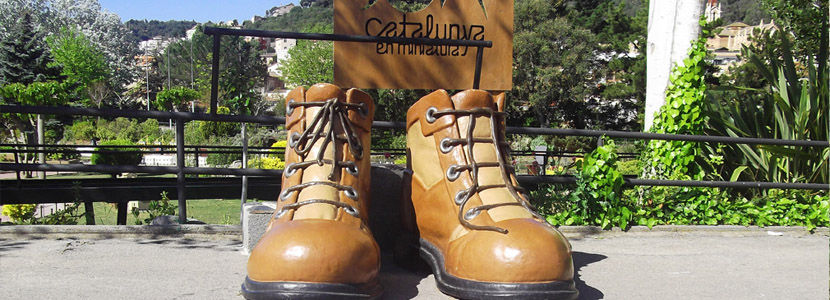
With the audioguide, you will encounter the biggest miniature theme park in Europe, featuring more than 150 of Catalonia’s landmark buildings on a scale of 1:25…..in other words 25 times smaller than the originals. All models have been handmade, using different densities of polyurethane because this petroleum-based material can be modelled and sculpted. It has the advantage of being able to withstand bad weather and won’t expand or shrink with changing temperatures.
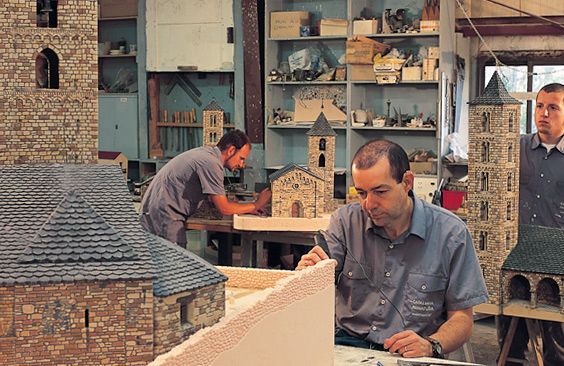
Before starting our visit we would like to remind you that the park has a coffee shop and WCs at your disposal. You can also find plenty of souvenirs at the park shop. Once you’ve been round the models with the audioguide you can take a ride on Jacob’s train which runs for 980 metres on a 15 inch gauge railway line. The journey, which lasts for over 10 minutes, gives you a complementary panoramic experience of the route we have already been on.
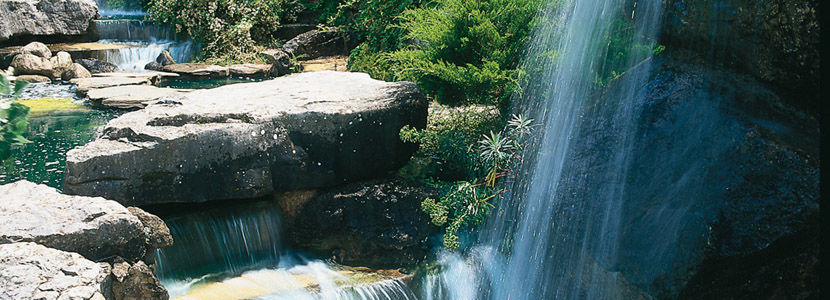
Finally, we have to tell you that on the other side of the park you can find the Enchanted Wood, an aerial forest with 66 activities in the trees. This is spread out in 4 different circuits with varying levels of difficulty for all age groups and they are designed for you to enjoy adventures and new sensations. If you enjoy a bit of a thrill then don’t miss the 150 metre long zip-wire!!!
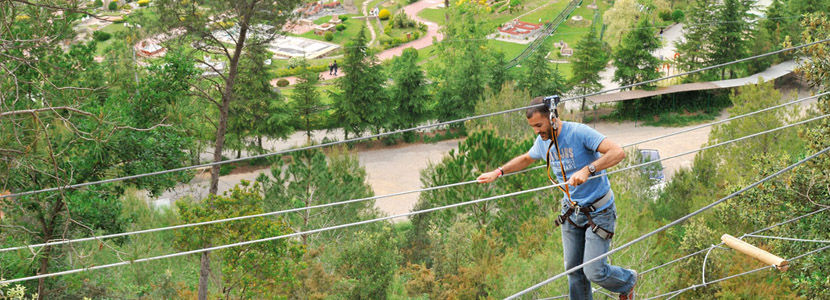
We are now going to start our audio-guided tour through the models. You will feel like a giant strolling in the open between miniature buildings. You have just passed between Gulliver’s legs at the entrance. (He is the storybook fellow who arrived on the island country of Lilliput). You can put on his boots before entering the miniature world. On your route you will also discover 3 kilometres of scale trains and 200 plant species which are the work of an expert gardener who works here with a great deal of patience and dedication.
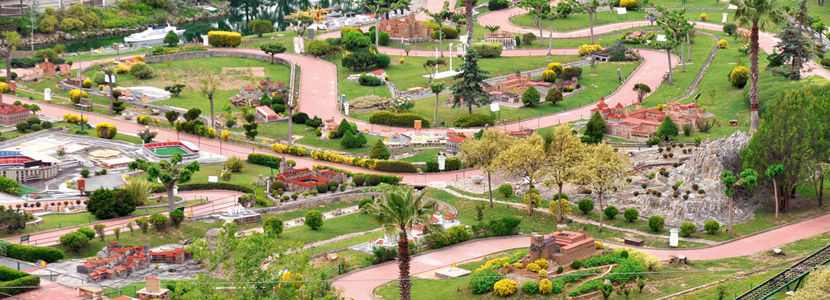
If you could fly like a bird you would see that the park is shaped like a map of Catalonia. We will begin the visit with the audioguide by going around the shores of a lake which represents the Mediterranean Sea. On we go!!!!
2. The Mediterranean Sea and Majorca Cathedral
The lake, which permanently holds 2 million litres of water, is a miniature representation of the Mediterranean Sea. Right in front of us we find the majestic Majorca Cathedral. Built between 1229 and 1346 its architecture is Gothic and it is the island’s most important religious monument.
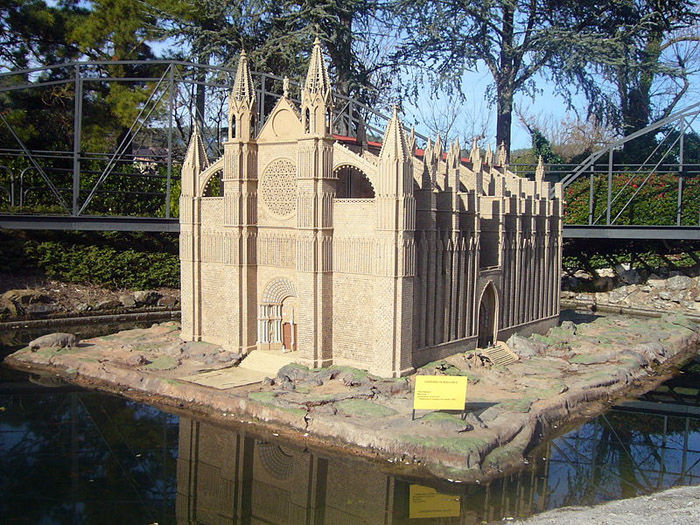
In the 20th century architect Antoni Gaudí carried out restoration work which lasted ten years and the demolition of numerous attached buildings of Mudéjar or Moorish architecture proved very controversial.
3. Barcelona Port and the Cable Car
We are approaching with the audioguide the largest port in the Mediterranean, the port of Barcelona. Press on the button you have in front of you and the cable car will start moving. It was built as part of Barcelona’s International Exposition in 1929. The cable car runs for a length of 1,303 metres and joins the Sant Sebastià beach with the Montjic Mountain.
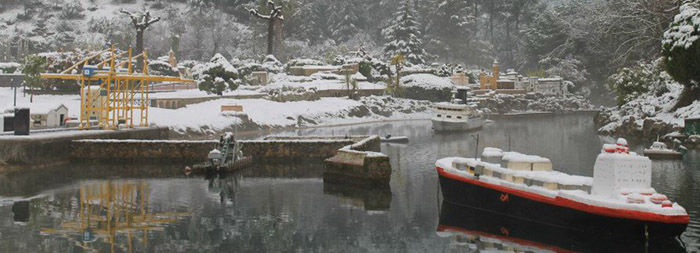
4. Entrance to Gerona and the Besalú Bridge
We are entering with the audioguide the province of Gerona, which has a population of 760,000 inhabitants, an eighth of which live in the province’s capital. Between the hills we can observe the Vell de Besalú Bridge, a magnificent example of Roman civil engineering erected over the Fluvia River. They took advantage of the perfect position of massive rocks on the banks of the riverbed as foundations for the bridge’s 7 rounded arches. It is made up of two stretches at oblique angles and is 145 metres long and 5 metres wide.
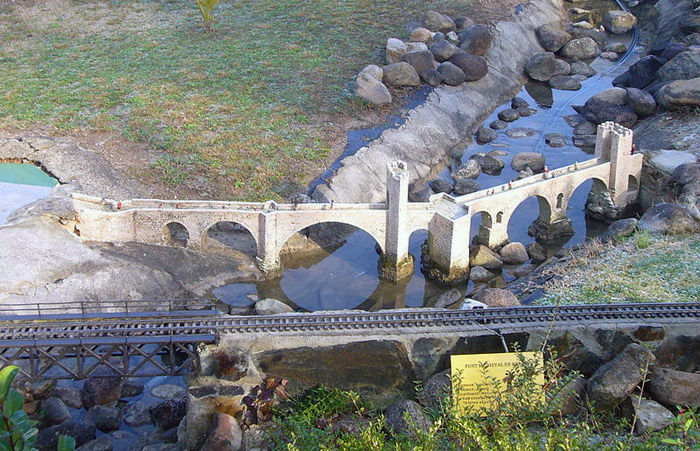
5. The San Pedro de Roda Monastery
The San Pedro de Roda Monastery is of pre-Roman architecture and was built on the sides of the Verdera Mountain at the feet of the ruins of the San Salvador de Verdera Castle, which gave protection centuries ago. The central part of the monuments dates from the 9th century. Its finest example is the church with the rest of the constructions around it that we can see with the audioguide. The true origin of the monastery is unknown, and this has led to numerous theories and legends.
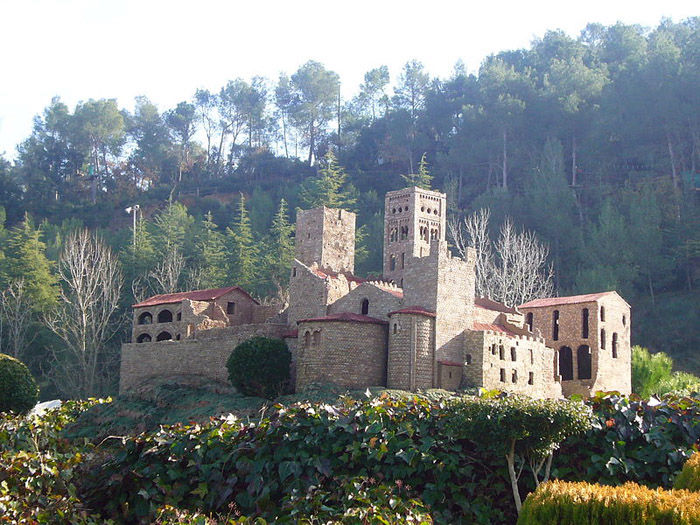
6. Ripoll and Santa María de Ripoll Monastery
The next collection of model buildings represents the town of Ripoll, which was founded around the Santa María Monastery. Erected in the year 888 this is an outstanding example of the area’s Romanesque past, even though it has suffered numerous extensions over the centuries.
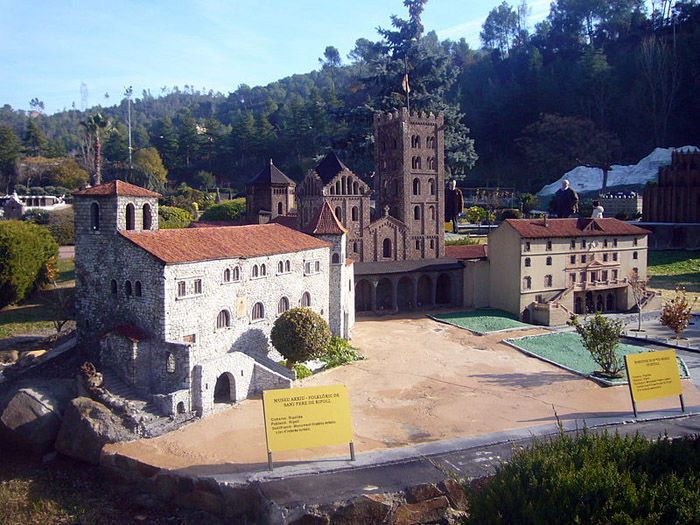
A strong earthquake in 1428 devastated the Ripollés region. The quake, with an intensity of IX on the Mercalli scale, was one of the strongest ever suffered in Catalonia’s history. It completely destroyed one of the monastery’s bell towers and badly affected the rest of the building. The damaged areas were rebuilt in a Gothic style and the last restoration was carried out towards the end of the 19th century.
7. Gerona Cathedral
Listening to the audioguide, we will find the magnificent Gerona Cathedral right at the top of a staircase of 99 steps. This cathedral has the widest Gothic nave in the world, spanning 23 metres.
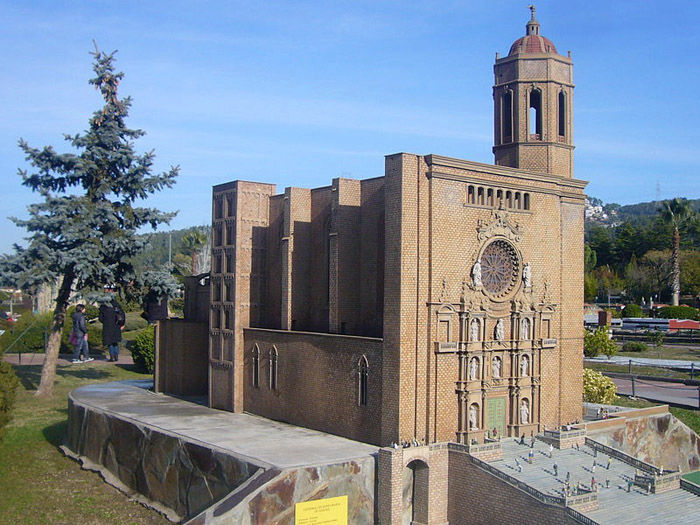
It began to be erected in Romanesque style during the 11th century and continued later with Gothic architecture during the 12th century. The building was completed in the 18th century. Right at the top you can see an angel. To begin with it was considered a symbol of faith because the eyes were covered by a bandage. But everyone knows it as the angel because of its wings and also because, being so high above the ground, nobody noticed the bandage.
8. Dalí’s Museum and the Torre Galatea
Dalí….Who hasn’t heard of this great surrealist Catalonian artist! This theatre-museum of Figueres is an example of the artist’s style. Indeed Dali personally took charge of the museum’s design and in fact his last bedroom and tomb can be found within the complex. If you look carefully you will see that the exterior of the facade is decorated with clusters of bread loaves.
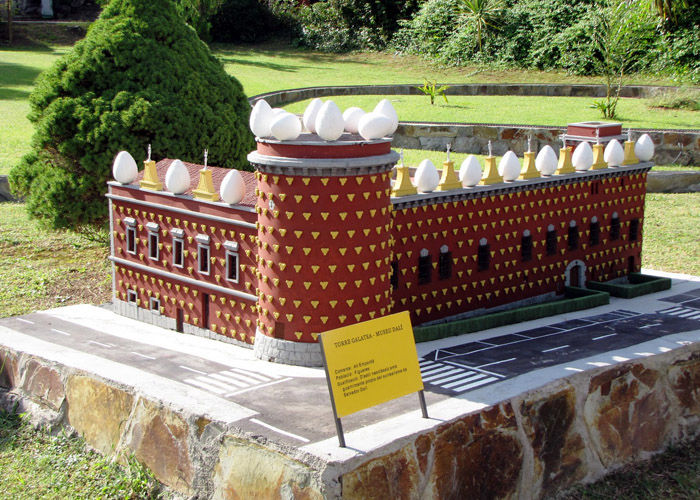
In the past the building was a theatre but it was destroyed during the Spanish Civil War. This theatre meant a great deal to Dalí because it was where he held his first exhibition. The exterior of the museum maintains the theatre’s neoclassic aspect, adorned with extravagant sculptures.
9. Botines House
The Botines House, or Casa Fernández and Andrés is a Neo-Gothic building in the city of Leon. It was designed and built by architect Antoni Gaudí between 1891 and 1894. It is one of his three constructions outside Catalonia, together with the Bishop’s Palace of Astorga, which is also in Leon, and the Capricho de Comillas in Cantabria. It was restored in 1951 and declared a Historic Monument in 1969. The name Casa Botines or the Botines House comes from Joan Homs Botinàs, a Catalonian businessman and merchant who established himself in Leon’s capital.
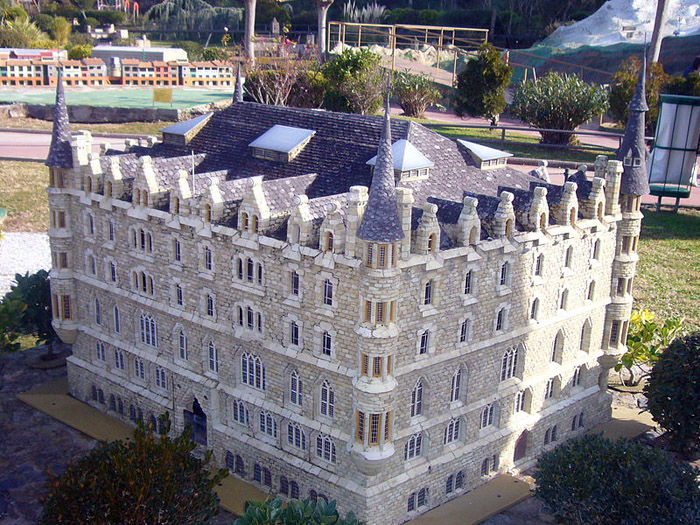
10. El Capricho
El Capricho is a building to be found in the Cantabrian town of Comillas and was designed in 1883 by architect Antoni Gaudí. The audioguide recommends you watch carefully the highlights in the structure, that include the porch’s pillars and the cylindrical, arborescent tower. Its decorations repeat sunflower motifs and combine a work of pathways, brickwork, wrought iron and ceramics with the playful and organic forms which were so characteristic of the Catalonian architect.
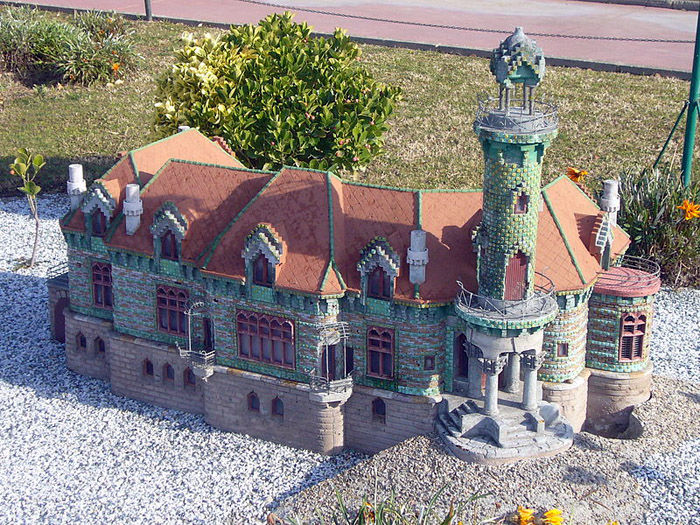
11. The Episcopal Palace of Astorga
The Bishop’s Palace of Astorga is the finest example of Catalonian modernism. The city didn’t have its own diocesan architect so Bishop Joan Baptista Grau decided to entrust his friend Gaudí to build the new Episcopal Palace in 1889.
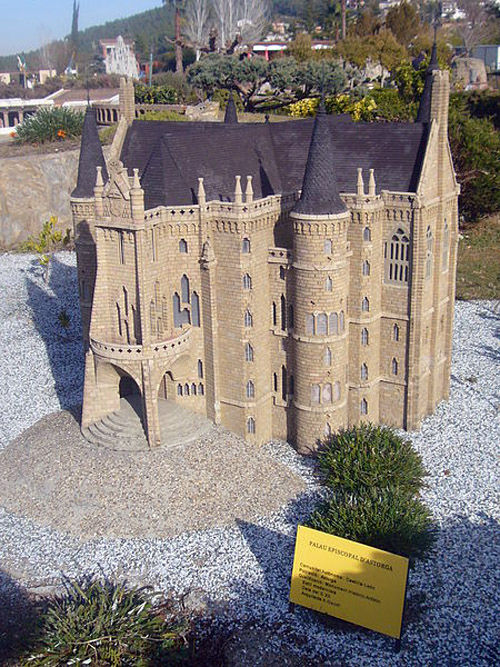
When Gaudí was given the job he was busy on a number of projects so he decided to use builders and construction workers who had already worked with him to make sure work was carried out precisely and in line with his ideas during his absence. The Palace has a medieval air to it, which is quite appropriate to its intended use. Gaudí designed it in Neo-Gothic architecture, a trend which came from the historicist school which was fashionable at the time.
12. Entrance to Barcelona and Güell Park
We are approaching with the audioguide the Province of Barcelona, the most populated in Catalonia with a population of 5.500.000 inhabitants, a third of which live in its capital, Barcelona.
Güell Park, a huge garden brimming with architectural structures, is situated in the upper part of the city and looks across the sea. It was designed by Antoni Gaudí, the best known of Catalonian modernist architects, and was created between 1900 and 1914. It covers 42 acres, making it one of the largest architectural works in the south of Europe. The UNESCO declared it a World Heritage Site in 1984.
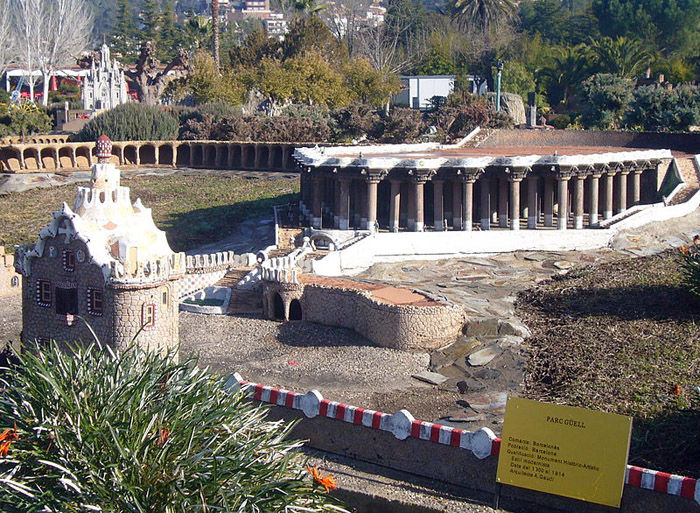
13. França Station
The audioguide welcomes you to Barcelona’s França Station, a railway terminal opened in 1929 and which has a monumental character comprising a huge, modernist style metallic structure.
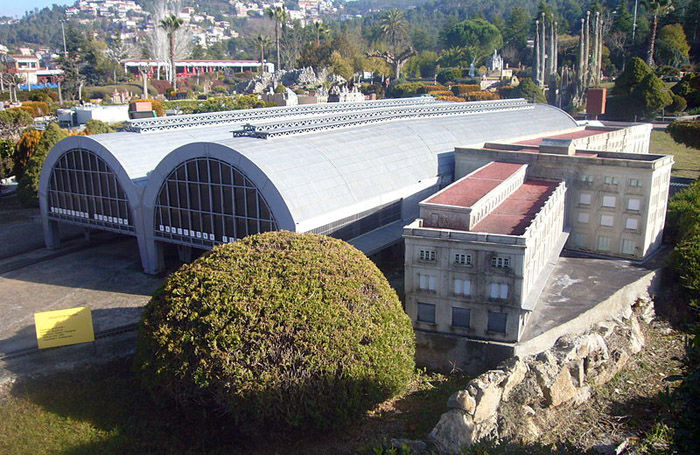
It was one of the last European stations erected in this architectural style and is now the only railway station in Barcelona which stands out because of its historic and artistic character. The buildings envelop the railway lines in a “U” shape and were constructed with what are considered to be luxury materials like marble and bronze, with decorative glass doors and windows.
14. The Holy Family
La Sagrada Familia, The Church of the Holy Family is the star of this park and 13,000 workshop hours were put into putting together this piece. On 31st December, 1881 Josep Maria Bocabella, owner of an old printer’s and a religious library, bought a plot of land for 172,000 Pesetas, money obtained from donations to erect a temple in honour of the Holy Family (Saint Joseph, the Virgin Mary and Child Jesus). Apart from the temple, the project also envisaged building schools.
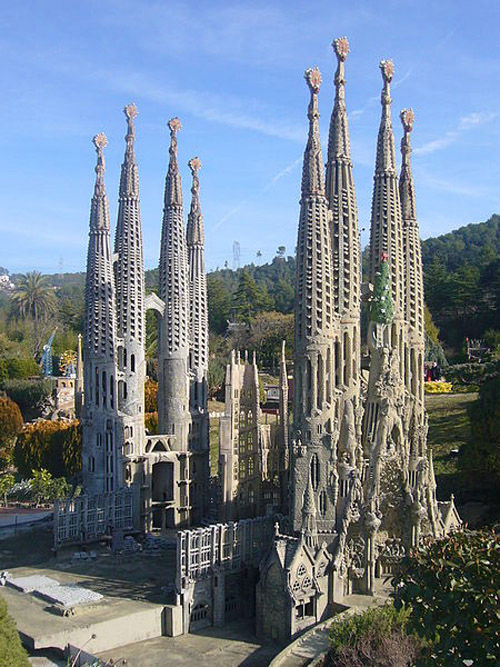
In 1883, a 31 year old Gaudí took charge of the construction. It was a very ambitious project. This consisted in building a unique and original temple, following naturalist-modernist trends and with a great 170 metres high central tower dedicated to Jesus Christ. The proposal was accepted enthusiastically and the architect dedicated the rest of his life to this project, exclusively during his last 15 years.
He decided to erect the highest, external and less functional elements, thus leaving plenty of evidence of his own personal style, to act as guidelines once he had passed away.
Antoni Gaudí was buried in the crypt, the chapel of the Mother of God of Carmen, on 12th June, 1926. The three remaining towers missing from the nativity facade were built between 1926 and 1936.
On 20th July, 1936, the day after the military uprising which led to the Spanish Civil War, a group of anti-clericals set fire to the temple and destroyed much of the workshop in which Gaudí had worked and where many of his drawings, models and master casts were kept.
As a result, and because of Gaudí’s peculiar working methods, all of his architect’s drawings and guidelines for completing the temple were lost. Therefore, the first thing they had to do in 1944 was to understand how to proceed in order to erect the building as faithfully as possible to Gaudí’s wishes.
They estimate the construction will be completed in about 2026. The temple was dedicated to worship and Pope Benedict XVI declared it a minor basilica on 7th November, 2010.
15. La Pedrera
The next stop of this audioguide, La Pedrera (the Quarry), is the most travelled model in the park. It’s even been to Tokyo! There is a special box designed for it to be transported safely. On the model you can see details of the terrace and banisters you would not easily appreciate by looking at the original building. It is of modernist architecture and it is to be found along the Gracia promenade in Barcelona. Built between 1906 and 1910, it became the last civil engineering work to have been designed by Gaudí. At the time it was quite controversial due to the stone facade’s bold, undulating shapes and twisted wrought ironwork which adorn the windows and balconies.
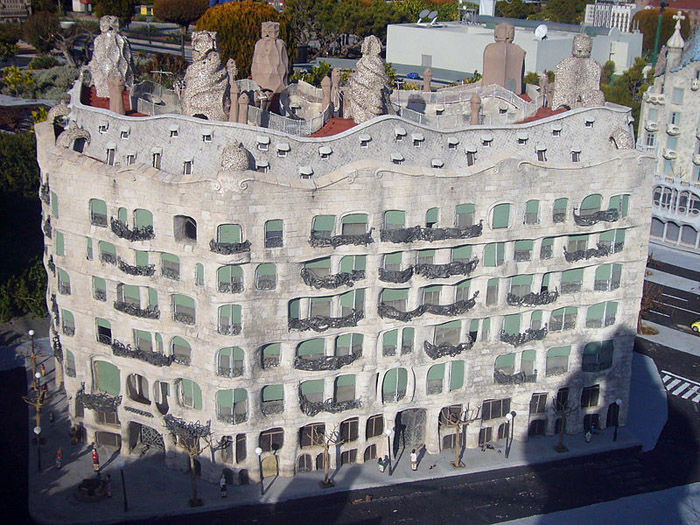
16. Casa Batlló
Casa Batlló was designed by Antoni Gaudí between 1904 and 1906. It is found in Barcelona’s Gracia promenade, a wide avenue that crosses the modernist district within the Ensanche, the name given to the city’s early 20th century extension. The house was commissioned by Josep Batlló Casanovas, a textile industrialist. Best known is the building’s exterior. Considered one of the architect’s most creative and original works, it combines stone, iron, Mosaic and polychrome ceramics. Let's continue our audio-guided tour.
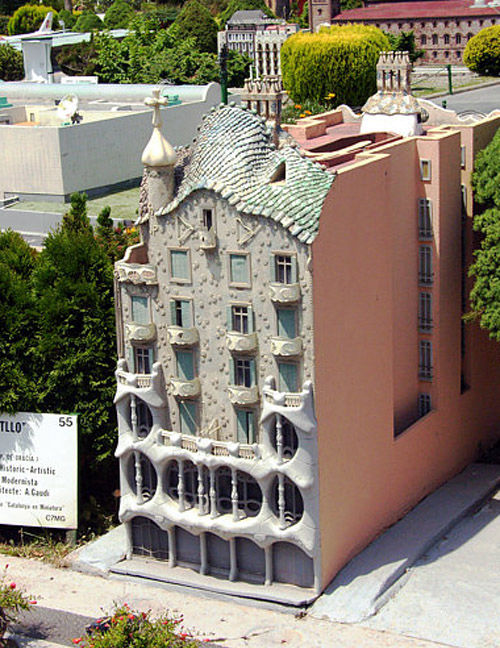
17. Barcelona Cathedral
Look at them folk-dancing in the cathedral square. Barcelona Cathedral was the first of the park’s models. The real cathedral was built during the 13th and 15th centuries on top of an ancient Romanesque cathedral which had also been erected on an earlier church from the Visigothic period. Three white geese live in its Gothic cloister.
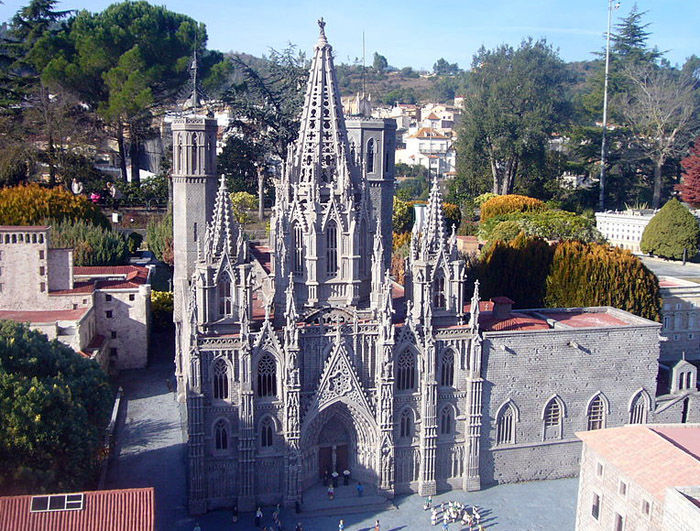
The cathedral the audioguide shows us has been dedicated to the Holy Cross since the year 599. Saint Eulalie, the city’s co-Patron Saint, was added later. As Catholic tradition goes, she was a young maiden who suffered torment during the Roman period.
18. Sant Jaume Square
Sant Jaume or Saint James’s Square, holds enormous historical value in spite of the fact that it dates from the early 19th century when the city hall’s new front was erected. In the square we can see the Palace of the Generalitat. It is one of the few remaining medieval buildings in Europe.
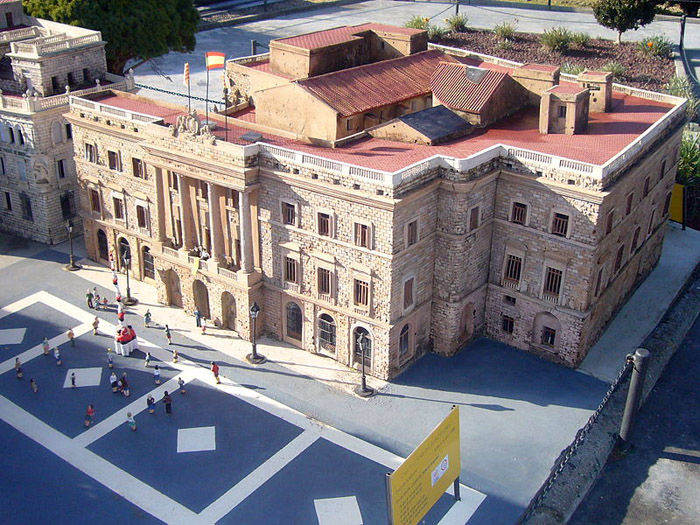
19. La Rambla and Columbus
La Rambla, the Boulevard, is full of people during the day and right into the late hours of the night. Here we can find newspaper kiosks, flowers, birds and even street performers. It comes out onto the old port where we see the famous Christopher Columbus monument. Erected in honour of the discoverer, the statue put the final touch to Barcelona’s coastal refurbishments carried out prior to the city’s Universal Exposition in 1888. There’s an elevator inside the column which takes visitors up to the hemisphere at the foot of the statue from which you can view the city with the audioguide. This model statue had to be made for a second time as the original was stolen.
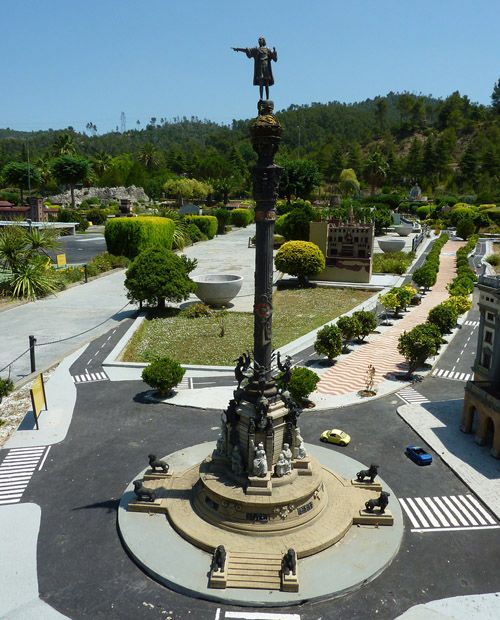
20. Güell Palace
In the next stop of this audioguide, we can find Güell Palace, which was designed by Antoni Gaudí, in the city’s Raval district. It was commissioned by Eusebi Güell, a wealthy Barcelona industrialist and great admirer of the architect, who funded a number of his best known works. This particular work belongs to Gaudí’s Orientalist period, between 1883 and 1888. The roof has 20 chimneys which were designed to be decorative so as not to appear awkward. This inspired him to begin chimney designs which he would develop in later buildings, culminating in the spectacular results to be seen in La Pedrera. The UNESCO declared the palace a World Heritage Site in 1984.
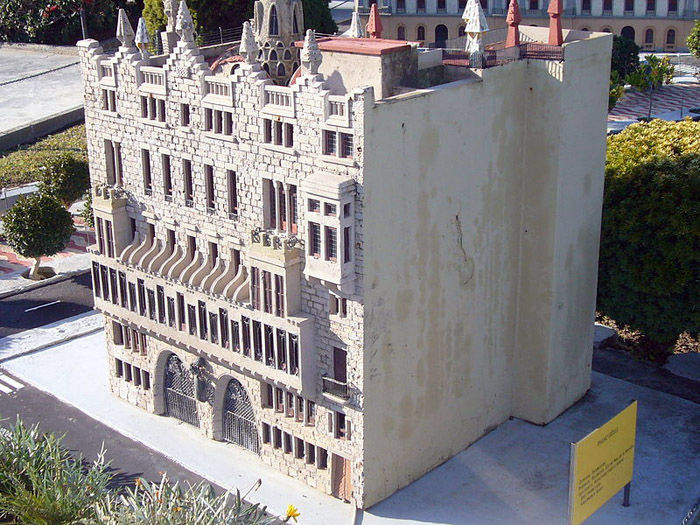
21. Barcelona University
The historic Barcelona University building is an architectural jewel which very often goes unnoticed by tourists. It was built between 1863 and 1889 and is currently home to the Philology and Mathematics Faculties. Barcelona University is Spain’s principal university research centres and one of the most important in Europe and the World because of the sheer number of its research programmes as well as its excellent standards.
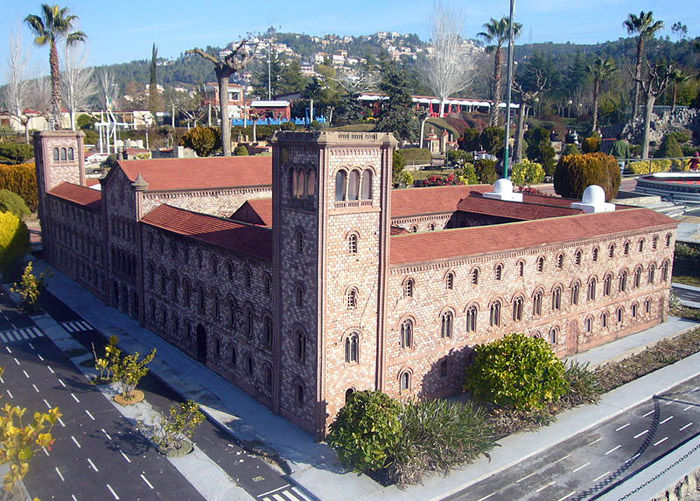
22. The Nou Camp
We are standing with the audioguide in front of a model made entirely of cement. The stadium, opened in 1957, has the biggest capacity in Europe and is the sixth largest in the World. It has been the venue for sporting events like the FIFA World Cup in 1982 and different events during the 1992 Olympic Games.
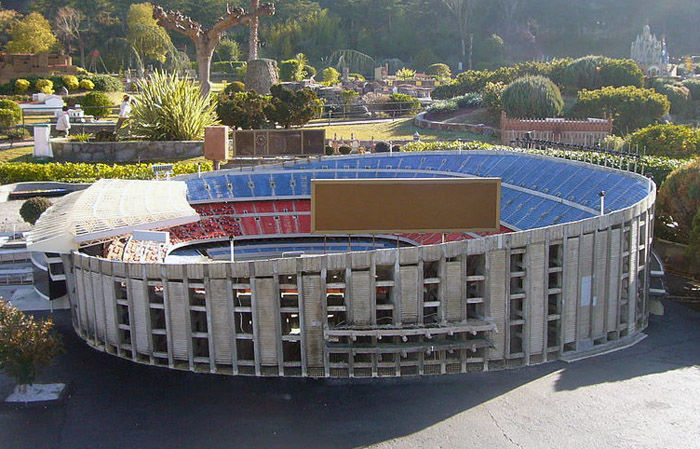
23. Bellesguard Tower
Bellesguard Tower, also known as Casa Figueras, is a house designed by Antoni Gaudí and built between 1900 and 1909 at the foot of Tibidabo Mountain. The remains of the 15th century palace belonging to King Martin the Humane, of the Catalonian royal dynasty, stood on the chosen site. The name “bell-esguard” derives from the beautiful view the King had from up there. The large number of windows reflects Gaudí’s search for natural lighting. The conical turret is crowned with a four-armed cross which is so characteristic of Gaudí’s work, and it is adorned with ceramics, showing the colours of the Catalonian flag in honour of Martin the Humane. It was declared a National Site of Cultural Interest in 1969.
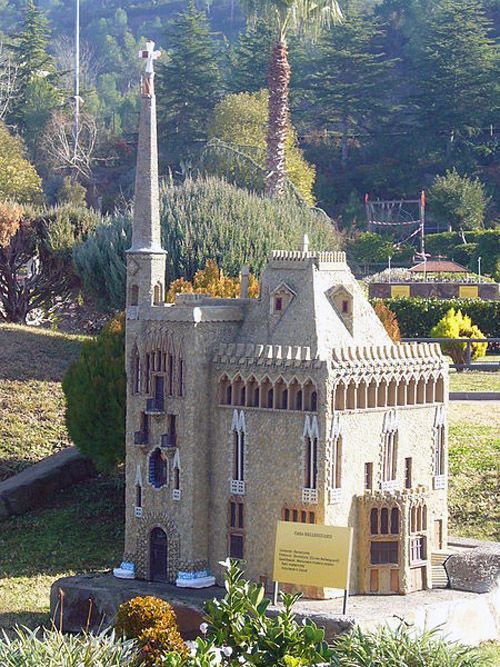
24. Casa Vicens
Casa Vicens is a modernist building dating from 1883 and it was Antoni Gaudí’s first important work. It is to be found with the audioguide in Barcelona’s Gracia district. It was a very imaginative project, commissioned by a family which owned a ceramics factory. This is evident from the exterior decoration based on ceramic tiles. He was inspired by vegetation found on the plot of land to design the more important decorative pieces, like the palmettos for the iron railings or the Moorish Carnation to adorn the facade’s ceramics.
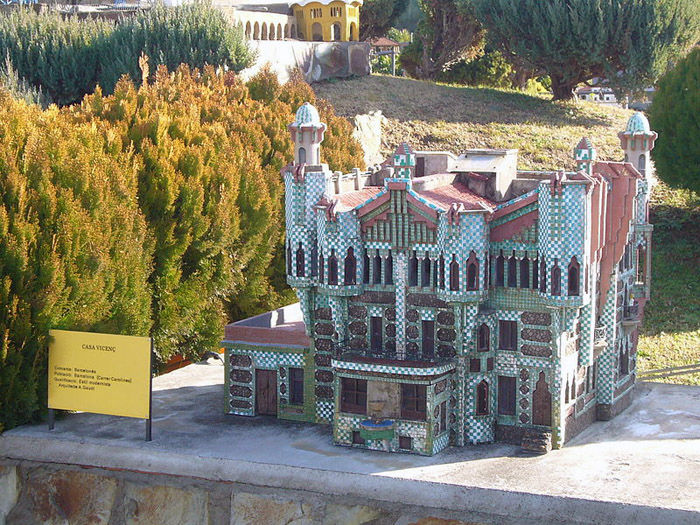
25. Casa Calvet
Casa Calvet or the Calvet House, which dates from 1899, was designed by architect Antoni Gaudí and is located in the Ensanche district. It is considered the architect’s most conservative work. Indeed, the symmetry, balance and order to be found in the Calvet House are not common features in Gaudinian architecture. The columns flanking the entrance remind one of stacked sewing bobbins in allusion to the Calvet family’s textile industry. In 1899 it became the first building to be awarded the annual prize for artistic buildings by the City Council and it has been classified as a National Site of Cultural Interest.
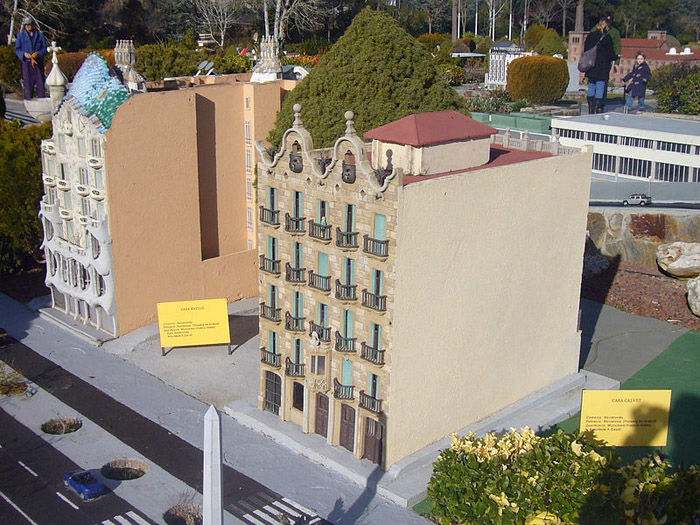
26. The Tibidabo
We are standing with the audioguide in front of Barcelona’s highest mountain. On the peak we can see the Expiatory Temple of the Sacred Heart which was built between 1902 and 1961. The exterior of the building looks like a walled stone enclosure presided over by a colossal Neo-Gothic temple with a grand double staircase. We can also find the Tibidabo Amusements Park. Inaugurated in 1901 it is the oldest in Spain and the third oldest in Europe.
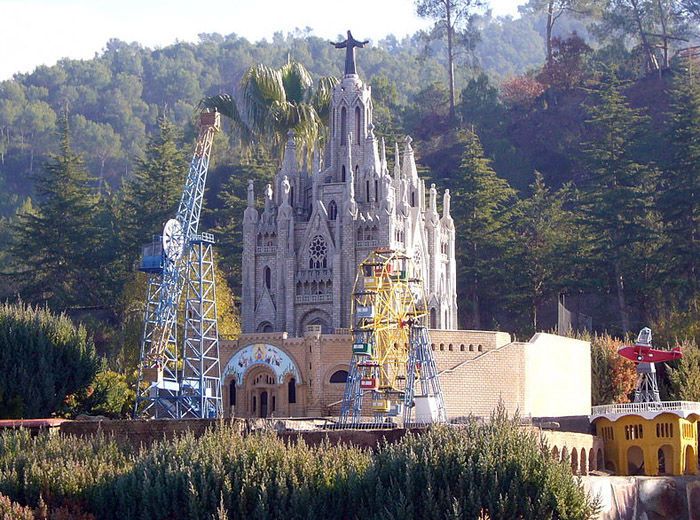
27. The Teresianas School
The Teresianas School was the work of Antoni Gaudí, although it was conceived by San Enrique de Ossó as a school and convent for the congregation of Teresian nuns, the Order of Saint Teresa of Jesus, which he himself had founded.
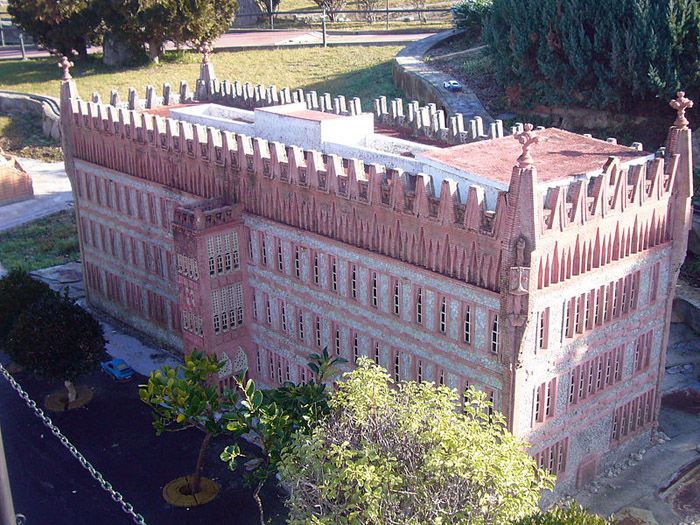
The building the audioguide shows us was not originally designed by Gaudí, who joined the Project in March, 1889, a year after the construction began. Ossó decided to entrust him with the project because of his tremendous reputation and also because Gaudí was a devout Christian. Gaudí carried out his instructions for the building to reflect austerity, complying with the Order’s vow. Nevertheless he did start adding a few decorative elements, both on the inside and the exterior of the building.
28. The Güell Estate
Eusebi Güell, Gaudí’s great benefactor, commissioned him to refurbish a Caribbean-style mansion. Güell had discovered the architect’s work at the Paris Universal Exposition in 1878, which marked the beginnings of a close friendship as well as a long list of orders. He carried out this particular project with an oriental touch that sometimes reminds one of Moorish Mudéjar art. He erected a limestone wall and highlighted the main gate with an iron grill shaped like a dragon with glass eyes. Above the gate he put an orange tree made of antimony.
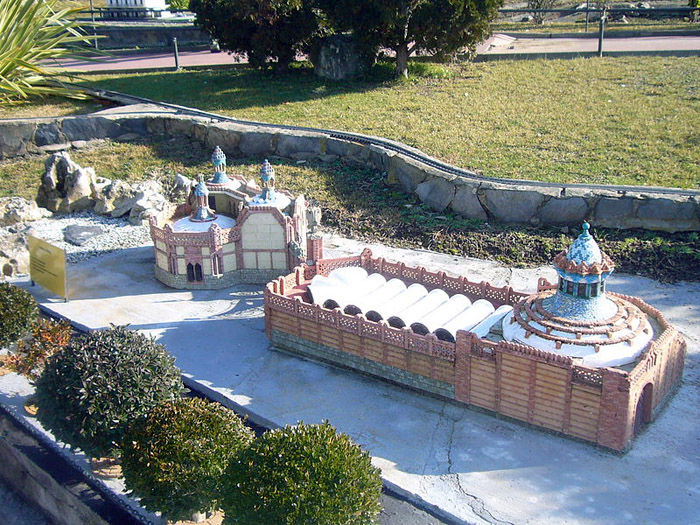
Gaudí was also partially responsible for designing the estate’s gardens. The estate was declared a National Historic-Artistic Monument in 1969. It is now also used as the headquarters for the Royal Gaudí Chair.
29. Rupit
Leaving behind the city we now proceed into the province of Barcelona to find ourselves with the audioguide in this medieval kind of town. The houses have been built in perfect harmony in amongst the hills, with narrow and steep streets. The village of Rupit is famous for its live nativity scenes, a hanging, wooden bridge and also for its castle which can be found on top of a rocky ridge.
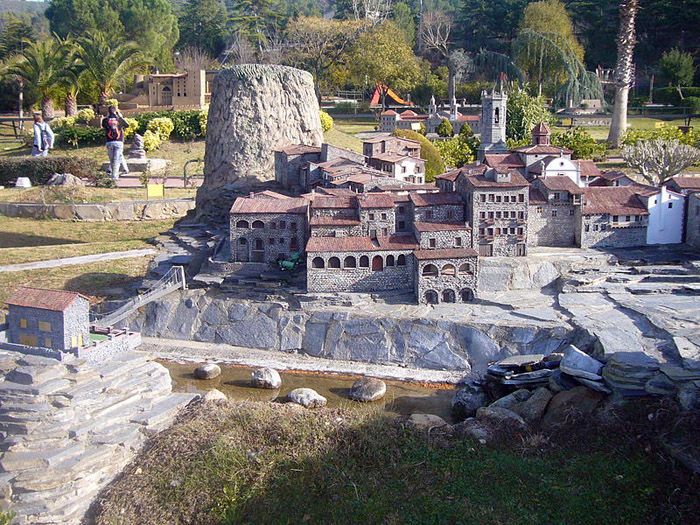
30. The Bañolas Lake
This is the largest lake in Catalonia. Scientists believe it was created as a result of water seeping from the Ter and Fluvià Rivers. Just like other lakes such as Loch Ness, it has a legend. In this case the legend suggests that, during their stay in Gerona, Charlemagne’s troops came to Bañolas to try to cut down and kill the dragon.
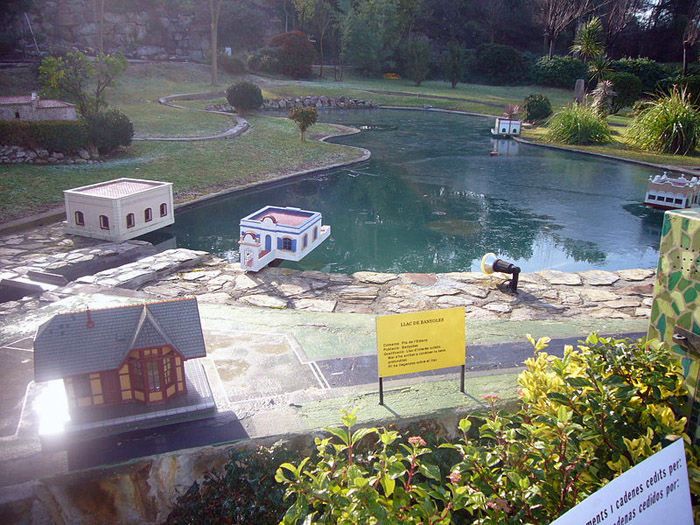
Saint Emetery, a French monk accompanying the emperor on his quest to fight the Moors, began to pray when the beast cameo out of its hiding place. The dragon stood staring at the monk and, as if it were a child, followed him as far as the square. After the incident the miracle-working monk founded the Monastery of Saint Stephen of Bañolas before going away to live in a cave inside a forest which was so dense that it was impossible to know whether it was day or night. The monster then returned to the lake where, it is said, it still resides. In our model reproduction you can easily make out the figure of eight shape of the lake, which you could never do at the actual scene.
31. The entrance to Lleida and Port de Comte
We are now entering with the audioguide the province of Lleida. It has a population of 450,000 inhabitants, a third of which live in the capital. This is where we can find the famous Aran valley, the Val d’Aran, a beautiful mountain enclave which has its own language, Aran. Port de Comte is the closest ski resort to Barcelona. Opened in 1973, it boasts 42 kilometres of skiable pistes.
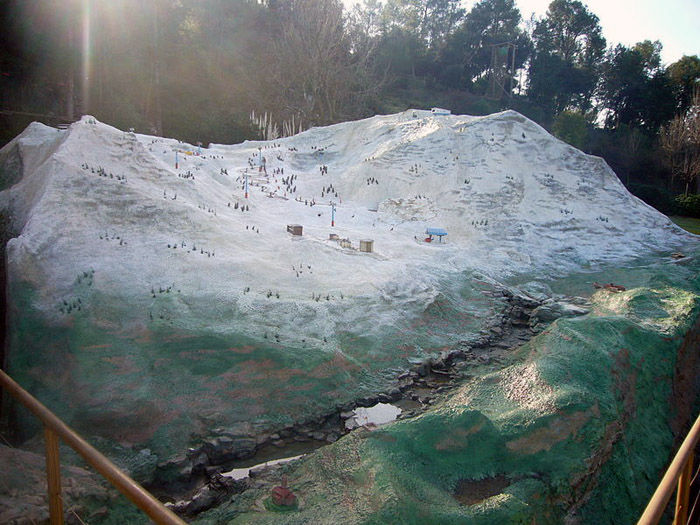
32. The Romanesque Val de Boí sites
What we see is a selection of nine Roman churches located in the Boí Valley in the Catalonian region of Alta Ribagorza and which have been declared World Heritage Sites by the UNESCO. The best known of these is the Roman Church of Saint Clement of Tahull. It was famous for its frescos representing Christ Pantocrator sitting on a transversal strip, decorated with drawings of plants within a pearled mandorla.
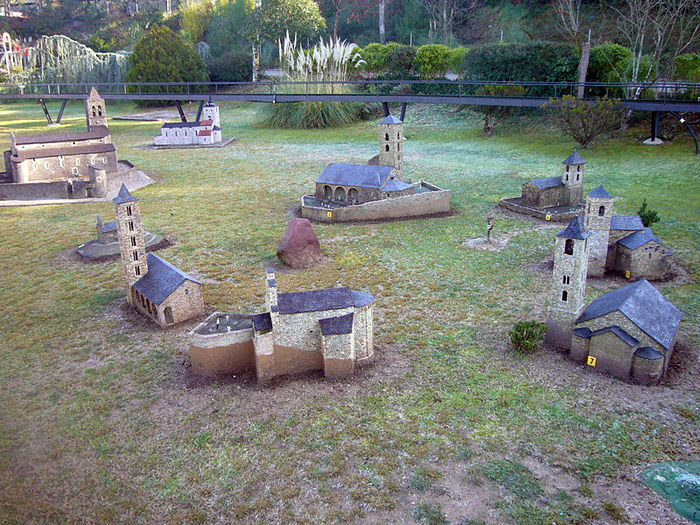
In the early 20th century there was great excitement about studying and listing the Roman murals found in the Val de Boí’s churches. These were “discovered” by scholars but they also captured the imagination of laymen whose only interest was economic.
33. La Seo de Urgel
Next stop of this audioguide, his city was once an ancient military fortress and capital of the County of Urgell in the middle ages until the capital was moved to Balaguer. The Diocese of Urgell includes part of the provinces of Lleida and Gerona as well as the whole of the Principality of Andorra. La Seo d’Urgell is its Episcopal Headquarters.
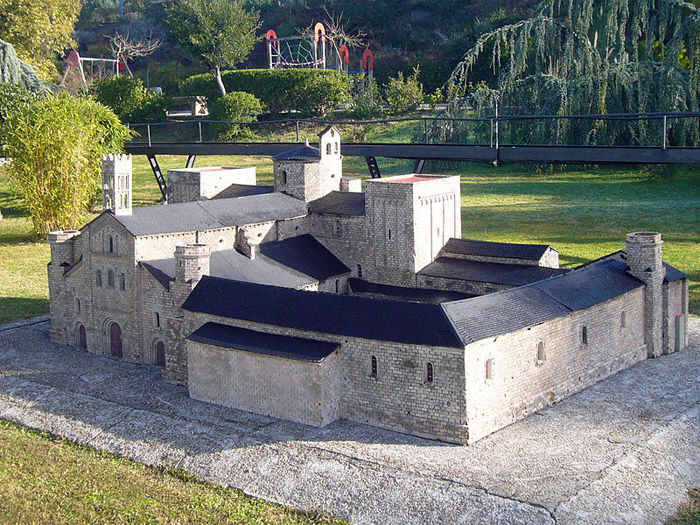
Urgell’s Santa María Cathedral is of Roman architecture and dates from the 12th century. Highlights include the attached cloisters, the Diocese Museum and the Church of Saint Peter and Saint Michael.
34. Cardona Castle
This castle we can see with the audioguide is arguably the most important medieval fortress in Catalonia. It sits up on a hill overlooking the Saline Valley and the Cardener River valley. It was built in the year 886 by Wifredo el Velloso. It consists of both Roman and Gothic architecture and includes the so-called Sala Dorada and Sala dels Entresols (the Golden and Mezzanine Halls). The Dukes of Cardona were the most important in the Aragon Crown territories, second only to the Royal Household, in the 15th century. Today the castle is a national parador state-run hotel.
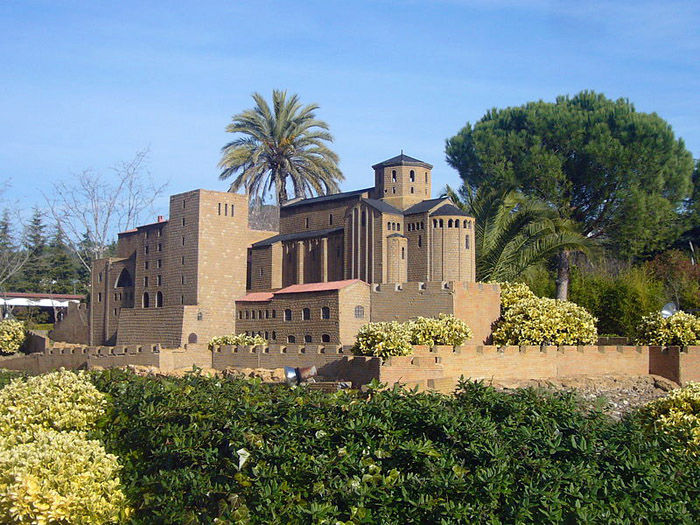
35. Monserrat
This is the rocky massif traditionally believed to be the most important and significant mountain in Catalonia. According to local legend, one Saturday evening in the year 880 a group of shepherds witnessed a bright light coming down from the sky, accompanied by heavenly music. The same happened on the following Saturday.
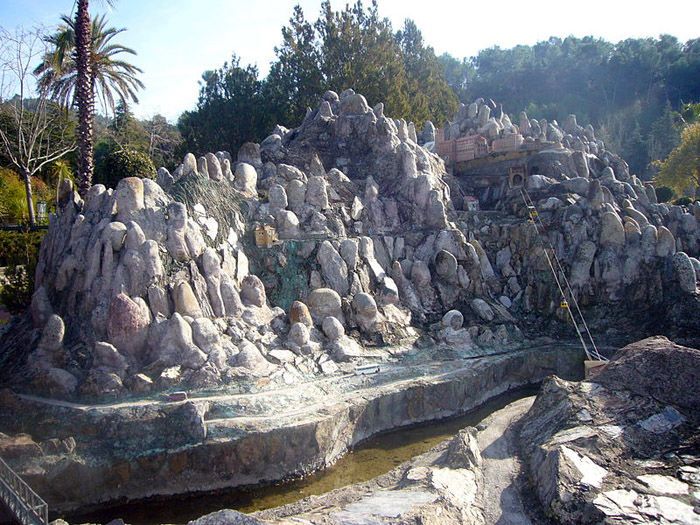
Hearing the news, the Bishop of Manresa arranged a visit during which they discovered a cave. Inside they found a Holy Image of the Virgin. The Bishop suggested moving the image to Manresa but when they attempted to take it out of the cave it became so heavy that they couldn’t move it. This was interpreted as a message from the Virgin that she wanted to stay there, so the Bishop ordered a chapel to be built. The Virgin, known traditionally as “La Moreneta” or the Black Madonna because of her dark colour, is a Romanesque sculpture dating from the 12th century. Amongst the various buildings belonging to the Benedictine Monastery, the Capitular Hall, the Neo-Romanesque cloisters and the Refectory all stand out for their architectural style. This model has been made to a 1.300 scale.
36. The Güell Colony
This workers’ colony we encounter with the audioguide was the brainchild of Count Eusebi de Güell. The project included a hospital, a boarding house, a school, shops, a theatre, a cooperative farm and a chapel, as well as the factories and workers’ houses. It covered a total area of 395 acres. Gaudí took all the measurements for the project.
Unfortunately they only built the crypt because Count Güell’s children abandoned the project. Gaudí had designed a church to be entirely integrated with nature, following the concepts he held regarding architecture as an organic structure. La crypt at Güell’s Colony served as a test bed in which to experiment with new structural solutions invented by him and which he later applied to works like the Holy Family.
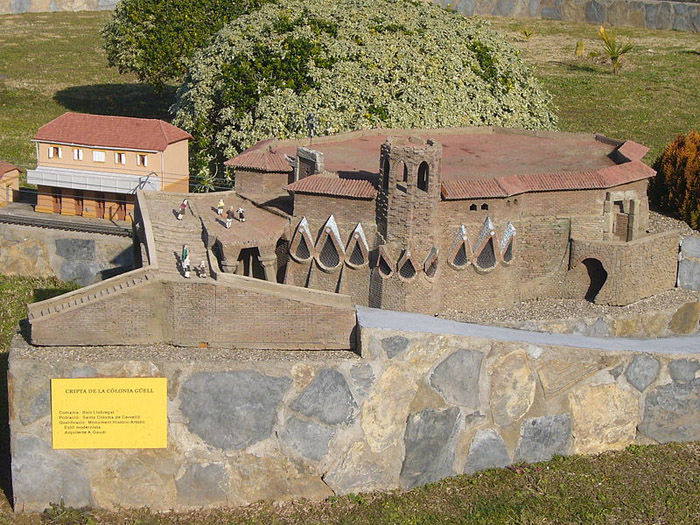
37. The Güell Garraf
Antoni Gaudí was commissioned to build these wine cellars and annexes by his principal benefactor, Eusebi Güell, who owned a number of vineyards in the Garraf region.
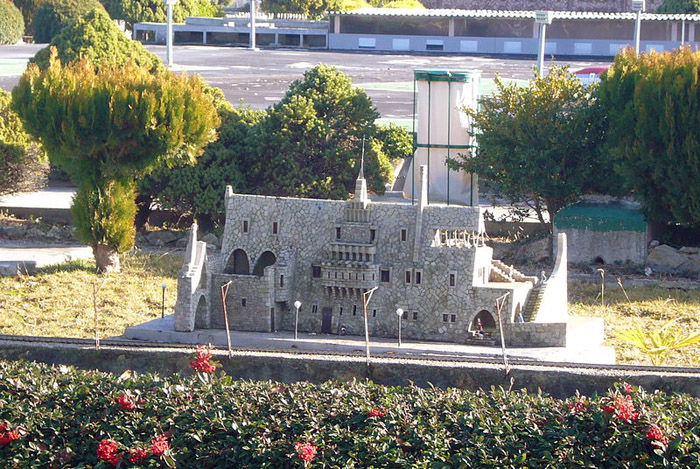
The bodegas are an example of Catalonian Modernist architecture and portray extremely original forms constructed with traditional materials like stone and brick. The construction we can see with the audioguide reminds one of a medieval architectural style, although the arches are parabolic rather than the typical semi-circular Romanesque shape. The porter’s lodge, which forms part of the main entrance, has got a magnificent doorway formed by interlinking chains.
38. The Police and Fire Station
The “mossos de esquadra” police station is the park’s latest model. It was added in March 2012 in honour of this public safety corps. A bit further on we will also find the Manresa fire station which includes a simulated training exercise. It was inaugurated to coincide with its 150th anniversary.
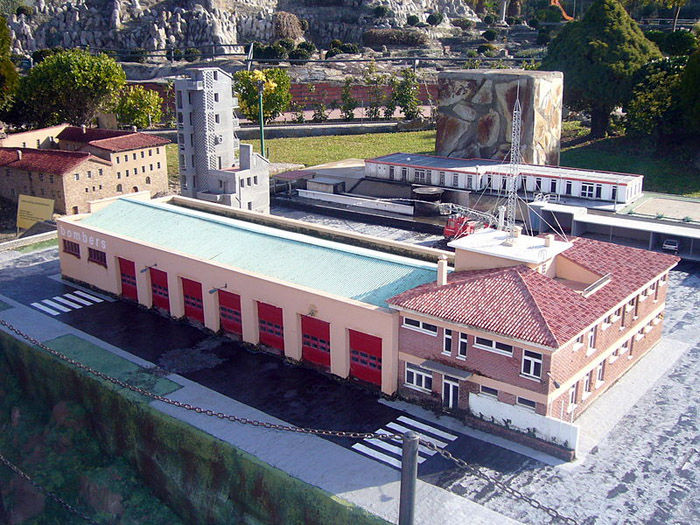
39. Cava
Cava is a sparkling wine produced by traditional methods in the Cava region of Spain, mainly in the Catalonian region of Penedés, in the provinces of Barcelona and Tarragona. San Sadurní d'Anoia is the most important production centre and the Regulating Board’s headquarters.
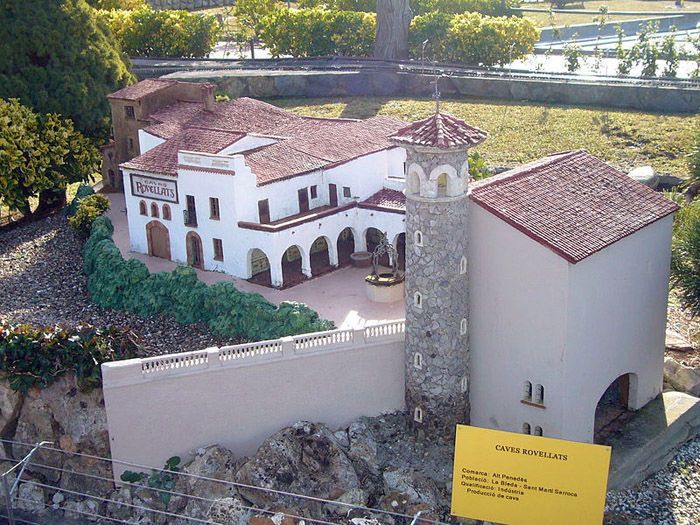
40. Poblet Monastery
Poblet Monastery was founded by the Count of Barcelona in the year 1150. Everything they needed to survive could once be found within the monastery’s walls without having to leave Poblet. Apart from the usual and primary provisions any monastery required, it also had a sickbay, a pharmacy, a cemetery, an aromatic plant garden, mills, a baker’s and even a prison cell because the abbot possessed the authority of a feudal lord.
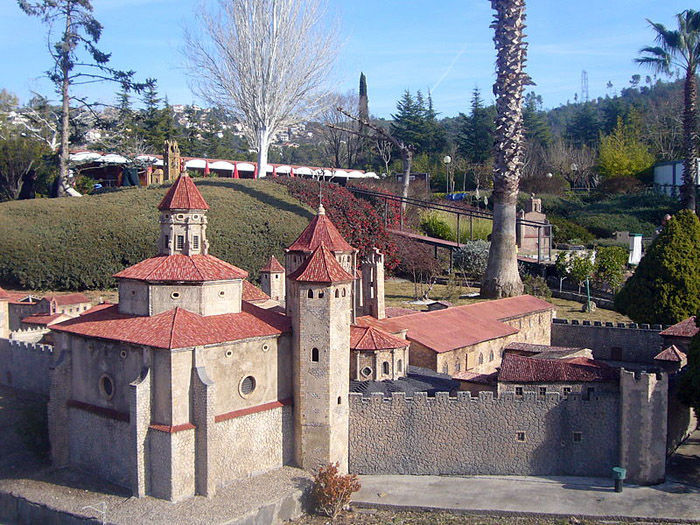
41. Entrance to Tarragona and Tarragona Cathedral
We are now going in to the province of Tarragona with the audioguide, which has 800.000 inhabitants of which one fifth live in the capital. Tarragona Cathedral was built in early Gothic architecture. It is located in the highest region of Tarragona on a plot once occupied by another shrine, the temple of Augustus, which was used for Imperial Roman worship, a Visigothic cathedral and a Moorish mosque.
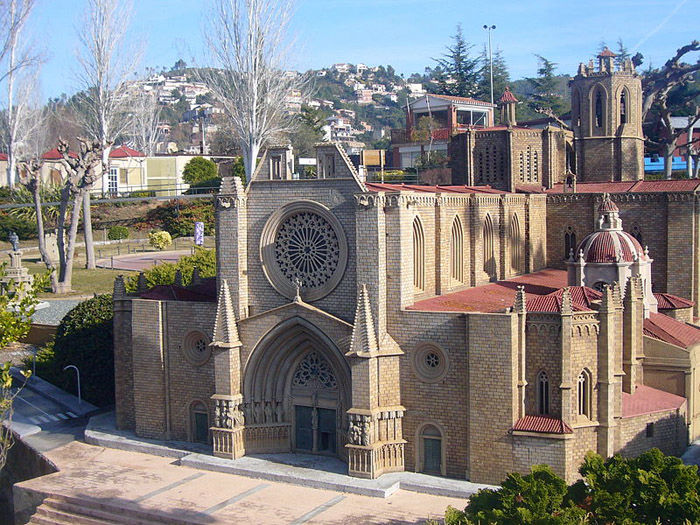
The Romanesque cathedral was also used in a defensive role and is built with parapets, battlements, patrol paths and even elevated windows which were out of the enemy’s reach.
42. The Wine Cathedral
The El Pinell de Brai’s Wine Cathedral, constructed between 1919 and 1922, was built by architect César Martinell disciple of Antoni Gaudí. The building has 4 naves: the main room is used to store wine, in the back is the second nave, the winemaking, and on a higher level, there is a grape-receiving area and water tank. The third room, known as the Fornal, was used as a wine aging room, and lastly, a two story nave intended for the oil mill.
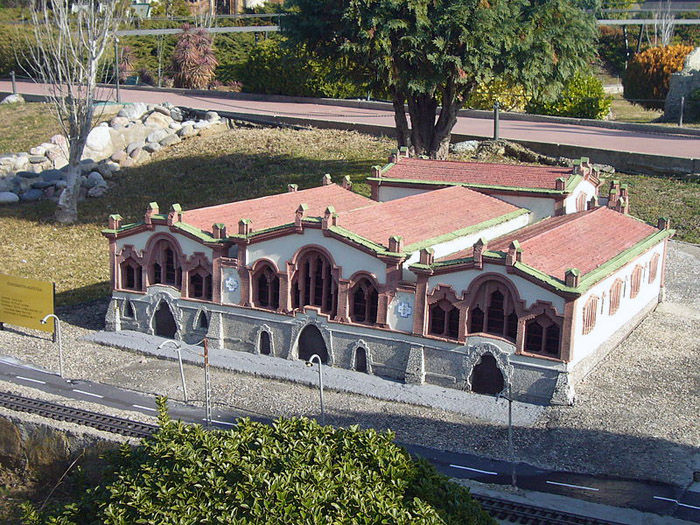
The El Pinell de Brai’s winery and olive mill are without a doubt one of the Catalan agrarian architecture’s jewels from the early twentieth century. The building is noteworthy for its special design and beauty as a whole, which has made it to be known as “the wine Cathedral par excellence”. The combination of brick, stone and glazed tile, give it an aesthetic effect not common in these types of buildings. The parabolic arches in the main room as well as the imposing façade announce the majesty of the building, which was declared a Site of National Interest by the Government of Catalonia in 2002. You can listen to the entire audioguide in the Audioguide Bluehertz webpage.
43. The La Zuda Castle
It was the as-sudda or the citadel of Lleida, of Andalusi origins. The remains of La Zuda, which have been restored, are up on the La Seu Vella hill, behind the ancient Lleida Cathedral. Evidence of its existence goes back to the year 882, when Lleida, known as Medina Larida, was under Saracen occupation. From its location it controlled a wide expanse of territory and had an excellent defensive position. Today it is also a national parador state-run hotel.
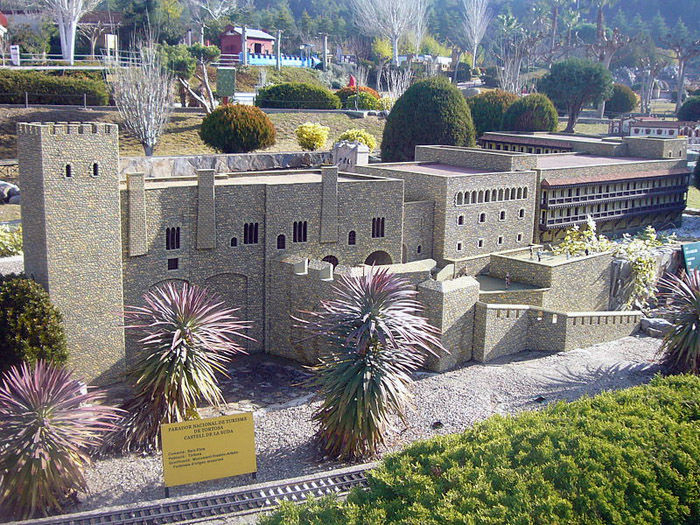
44. Lleida Cathedral
This is the city’s most emblematic building. It was built in Romanesque style although it does have Gothic cross-ribbed vaults. The cathedral front and capitals brought about an important Roman school of architecture known as The Lerida School. In its magnificent cloister you can see that every arch is different. An exterior corridor overlooks the city. The Cathedral was built between the 13th and 14th centuries and completed in the 15th century with the erection of the bell tower and the Door of the Apostles.
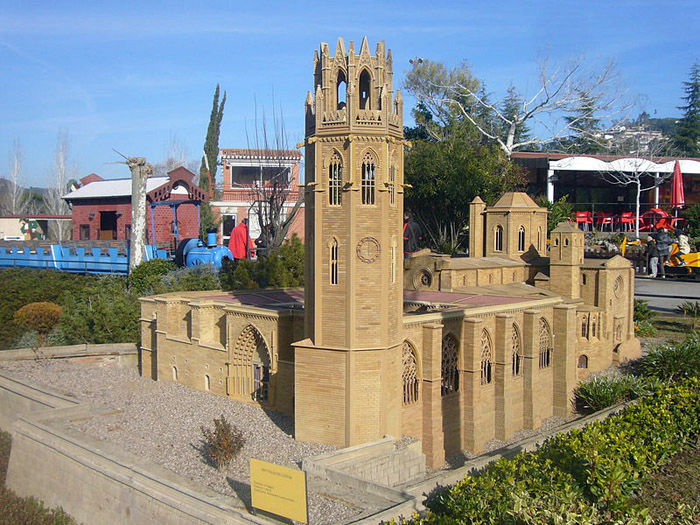
iven the importance of its strategic position the Cathedral became a military barracks in 1707, never again being used for religious purposes. The Cathedral maintains its original architectural style without having been modified with other styles. We are at the end of our audio guided tour and in just an hour and a half you have visited Catalonia’s most representative places of interest. May we remind you that you have the park’s different services at your disposal, like our souvenir shop and restaurant.
Bluehertz Audio guides has developed for Catalunya in Miniature Park an audio guide service avaliable in Spanish, Catalan, English and Rusian languages.
Catalunya in Miniature Park address: Can Balasch de Baix, S/N - 08629 - Torrelles de Llobregat, Barcelona.
- Tel.: + 34 936 890 960 - www.catalunyaenminiatura.com - info@catalunyaenminiatura.com -
Back to index